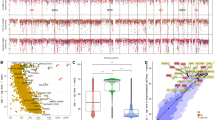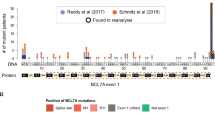Abstract
Genomic instability promotes tumorigenesis and can occur through various mechanisms, including defective segregation of chromosomes or inactivation of DNA mismatch repair1. Although B-cell lymphomas are associated with chromosomal translocations that deregulate oncogene expression2, a mechanism for genome-wide instability during lymphomagenesis has not been described. During B-cell development, the immunoglobulin variable (V) region genes are subject to somatic hypermutation in germinal-centre B cells3. Here we report that an aberrant hypermutation activity targets multiple loci, including the proto-oncogenes PIM1, MYC, RhoH/TTF (ARHH) and PAX5, in more than 50% of diffuse large-cell lymphomas (DLCLs), which are tumours derived from germinal centres. Mutations are distributed in the 5′ untranslated or coding sequences, are independent of chromosomal translocations, and share features typical of V-region-associated somatic hypermutation. In contrast to mutations in V regions, however, these mutations are not detectable in normal germinal-centre B cells or in other germinal-centre-derived lymphomas, suggesting a DLCL-associated malfunction of somatic hypermutation. Intriguingly, the four hypermutable genes are susceptible to chromosomal translocations in the same region, consistent with a role for hypermutation in generating translocations by DNA double-strand breaks4,5,6. By mutating multiple genes, and possibly by favouring chromosomal translocations, aberrant hypermutation may represent the major contributor to lymphomagenesis.
This is a preview of subscription content, access via your institution
Access options
Subscribe to this journal
Receive 51 print issues and online access
$199.00 per year
only $3.90 per issue
Buy this article
- Purchase on Springer Link
- Instant access to full article PDF
Prices may be subject to local taxes which are calculated during checkout




Similar content being viewed by others
References
Lengauer, C., Kinzler, K. W. & Vogelstein, B. Genetic instabilities in human cancers. Nature 396, 643–649 (1998).
Dalla-Favera, R. & Gaidano, G. in Cancer. Principles and Practice of Oncology (ed. DeVita, V. T. Jr, Hellman S. & Rosenberg, S. A.) 2215–2235 (Lippincott Williams & Wilkins, Philadelphia, 2001).
Klein, U. et al. Somatic hypermutation in normal and transformed human B cells. Immunol. Rev. 162, 261–280 (1998).
Goossens, T., Klein, U. & Küppers, R. Frequent occurrence of deletions and duplications during somatic hypermutation: implications for oncogene translocations and heavy chain disease. Proc. Natl Acad. Sci. USA 95, 2463–2468 (1998).
Papavasiliou, F. N. & Schatz, D. G. Cell-cycle-regulated DNA double-stranded breaks in somatic hypermutation of immunoglobulin genes. Nature 408, 216–221 (2000).
Bross, L. et al. DNA double-strand breaks in immunoglobulin genes undergoing somatic hypermutation. Immunity 13, 589–597 (2000).
Pasqualucci, L. et al. BCL-6 mutations in normal germinal center B cells: evidence of somatic hypermutation acting outside Ig loci. Proc. Natl Acad. Sci. USA 95, 11816–11821 (1998).
Shen, H. M., Peters, A., Baron, B., Zhu, X. & Storb, U. Mutation of BCL-6 gene in normal B cells by the process of somatic hypermutation of Ig genes. Science 280, 1750–1752 (1998).
Müschen, M. et al. Somatic mutation of the CD95 gene in human B cells as a side-effect of the germinal center reaction. J. Exp. Med. 192, 1833–1840 (2000).
Storb, U. et al. Cis-acting sequences that affect somatic hypermutation of Ig genes. Immunol. Rev. 162, 153–160 (1998).
Migliazza, A. et al. Frequent somatic hypermutation of the 5′ noncoding region of the BCL6 gene in B-cell lymphoma. Proc. Natl Acad. Sci. USA 92, 12520–12524 (1995).
Rabbitts, T. H., Hamlyn, P. H. & Baer, R. Altered nucleotide sequences of a translocated c-myc gene in Burkitt lymphoma. Nature 306, 760–765 (1983).
Cuypers, H. T. et al. Murine leukemia virus-induced T-cell lymphomagenesis: integration of proviruses in a distinct chromosomal region. Cell 37, 141–150 (1984).
Akasaka, H. et al. Molecular anatomy of BCL6 translocations revealed by long-distance polymerase chain reaction-based assays. Cancer Res. 60, 2335–2341 (2000).
Hoover, D., Friedmann, M., Reeves, R. & Magnuson, N. S. Recombinant human pim-1 protein exhibits serine/threonine kinase activity. J. Biol. Chem. 266, 14018–14023 (1991).
Shirogane, T. et al. Synergistic roles for Pim-1 and c-Myc in STAT3-mediated cell cycle progression and antiapoptosis. Immunity 11, 709–719 (1999).
Dang, C. V. c-Myc target genes involved in cell growth, apoptosis, and metabolism. Mol. Cell. Biol. 19, 1–11 (1999).
Raffeld, M. et al. Clustered mutations in the transcriptional activation domain of Myc in 8q24 translocated lymphomas and their functional consequences. Curr. Top. Microbiol. Immunol. 194, 265–272 (1995).
Cesarman, E., Dalla-Favera, R., Bentley, D. & Groudine, M. Mutations in the first exon are associated with altered transcription of c-myc in Burkitt lymphoma. Science 238, 1272–1275 (1987).
Gu, W., Bhatia, K., Magrath, I. T., Dang, C. V. & Dalla-Favera, R. Binding and suppression of the Myc transcriptional activation domain by p107. Science 264, 251–254 (1994).
Preudhomme, C. et al. Nonrandom 4p13 rearrangements of the RhoH/TTF gene, encoding a GTP-binding protein, in non-Hodgkin's lymphoma and multiple myeloma. Oncogene 19, 2023–2032 (2000).
Morrison, A. M., Nutt, S. L., Thevenin, C., Rolink, A. & Busslinger, M. Loss- and gain-of-function mutations reveal an important role of BSAP (Pax-5) at the start and end of B cell differentiation. Semin. Immunol. 10, 133–142 (1998).
Shen, H. M., Michael, N., Kim, N. & Storb, U. The TATA binding protein, c-Myc and survivin genes are not somatically hypermutated, while Ig and BCL6 genes are hypermutated in human memory B cells. Int. Immunol. 12, 1085–1093 (2000).
Jungnickel, B. et al. Clonal deleterious mutations in the IκBα gene in the malignant cells in Hodgkin's lymphoma. J. Exp. Med. 191, 395–402 (2000).
Neuberger, M. S. et al. Monitoring and interpreting the intrinsic features of somatic hypermutation. Immunol. Rev. 162, 107–116 (1998).
Zan, H. et al. Induction of Ig somatic hypermutation and class switching in a human monoclonal IgM+ IgD+ B cell line in vitro: definition of the requirements and modalities of hypermutation. J. Immunol. 162, 3437–3447 (1999).
Gamberi, B. et al. Microsatellite instability is rare in B-cell non-Hodgkin's lymphomas. Blood 89, 975–979 (1997).
Muramatsu, M. et al. Class switch recombination and hypermutation require activation-induced cytidine deaminase (AID), a potential RNA editing enzyme. Cell 102, 553–563 (2000).
Cigudosa, J. C. et al. Cytogenetic analysis of 363 consecutively ascertained diffuse large B-cell lymphomas. Genes Chromosom. Cancer 25, 123–133 (1999).
Pasqualucci, L., Neri, A., Baldini, L., Dalla-Favera, R. & Migliazza, A. BCL-6 mutations are associated with immunoglobulin variable heavy chain mutations in B-cell chronic lymphocytic leukemia. Cancer Res. 60, 5644–5648 (2000).
Acknowledgements
We thank V. Miljkovic and A.-M. Babiac for assistance in DNA sequencing; C. Göttlinger for help with the single-cell sorting; M. Introna for providing the sequence of the A-MYB gene, and B. Jungnickel for providing DNA from sorted human naive and germinal-centre B-cell populations. We are grateful to U. Klein for discussions and to R. Baer for critically reading the manuscript. L.P. was a Fellow of the American Italian Cancer Foundation. P.N. was supported by the Max Kade Foundation. This work was supported by grants from the National Institute of Health to R.D.-F. and R.S.K.C., and from the Deutsche Forschungsgemeinschaft and a Heisenberg Award to R.K.
Author information
Authors and Affiliations
Corresponding author
Rights and permissions
About this article
Cite this article
Pasqualucci, L., Neumeister, P., Goossens, T. et al. Hypermutation of multiple proto-oncogenes in B-cell diffuse large-cell lymphomas. Nature 412, 341–346 (2001). https://doi.org/10.1038/35085588
Received:
Accepted:
Issue Date:
DOI: https://doi.org/10.1038/35085588
Comments
By submitting a comment you agree to abide by our Terms and Community Guidelines. If you find something abusive or that does not comply with our terms or guidelines please flag it as inappropriate.



